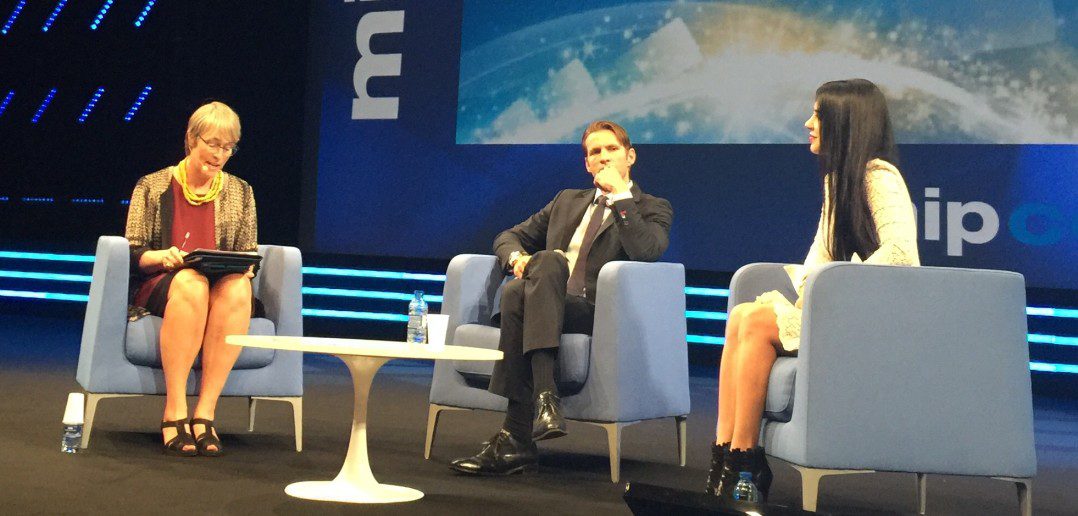Earlier this year, AOL’s The Huffington Post and BroadbandTV announced a partnership to work on Outspeak, a « next-generation video network » for journalists and creators to put their work on both company’s platforms.
Today at MIPCOM, AOL’s executive vice president and vice president of AOL Content and Consumer Brands Jimmy Maymann and BroadbandTV’s chief executive Shahrzad Rafati held a joint keynote to explain their strategy, and the market conditions that influenced it. Journalist Kate Bulkley moderated.
Rafati kicked off, talking about BroadbandTV’s 5.7bn monthly impressions and network of 37,000 creators. « Our goal is really to be the lynchpin, the centre of this whole ecosystem, » she said. « Combining strong brands, and coupling that with leveraging technology and social. »
She’s described her network as « smart Vice Media » in the past, and explained why: « Vice and Viacom built brands that really mattered to millennials… but really where we are today is an evolution of that… Content, ultimately is king. But you do need to leverage mobile, social and technology to get smarter. »
What are BroadbandTV’s international ambitions? It recently bought a child-focused MCN called YoBoHo in India, for example. « We’re the second largest video entertainment network in the world, but we’re also number one in Latin America and Brazil, » she said.
« We definitely do have an international network. The goal is for us, as we’ve built this strong ecosystem… when you look at this day and age, especially with digital, we need to understand that global, social and mobile are three key factors that we need to pay attention to. »
Over to Maymann, who was asked about the recent acquisition of AOL by telco Verizon. « I don’t think it’s changed what we’ll be doing. It’s accelerated it, » he said.
« For a lot of time we’ve talked about mobile as the second screen. For most of our audience today it’s the first screen… We need to accelerate our shift into mobile. And it’s a shift that’s happening at a tremendous pace. »
« We’re doing everything from six-second Vine things to eight hours of live-streaming every day, » he said. « We need to accelerate even more. The audience is there, they want more video. As I look across our properties, 20% of what we serve up is a video… but in the US, a third of what people do when they log on to their mobile phones is watch video… So we need to do more. »
Bulkley asked about AOL’s budgets for licensing in video. « With the right idea, I don’t think there’s a limit, » he said. « Co-producing is something we want to do more. » But that’s not just with television producers: it’s also with the stars emerging from YouTube and other social platforms.
Maymann talked about AOL’s live-video strategy. « We’re doing eight hours of live with HuffPost live, but it’s not [just]that kind of live. It’s those big live events: still things that you need to see in real-time, because social becomes really important, » he said.
« People are moving away from live TV… but there are things, there are events, where if you’re not there live, it doesn’t really make any sense, and you can’t be part of the conversation. » He talked about the importance of live-streaming apps like Periscope and Meerkat, and the potential for someone like AOL to curate that content within its own service.
Where’s the money in all this, wondered Bulkley. « One of the important things is to find ways of integrating it in, » he said. « The advertisers, these types of event resonate with the audiences they have. So we try to find intelligent way of integrating them into those live streams. »
Rafati talked about the differences between the TV world and the online video world, and how a company like BroadbandTV makes the latter work financially. She cited some key factors.
First: « cost effective premium content models » from having access to a network of creators that is scalable. Second; « Having a digital-first model online. When you’re programming for the millennials, you have to think about your content sitting on digital first, » she said.
« The other thing we need to think about is customer optimisation. Traditional media companies need to learn from the Googles and Facebooks of the world… they need to understand that they can no longer be just media companies, they need to become media and technology companies. »
The conversation turned to Outspeak, the joint venture between the two companies, which was announced in June. How is it different from what someone like Vice News is doing?
« What’s different here is really the contributor part: it’s the citizen journalism, which Vice is not really doing, » said Maymann. « The whole contributor part, the media has been democratised, but traditional media hasn’t really accepted that it’s been democratised. So how do we leverage that? »
Outspeak is aiming to discover new talent in the citizen-journalism world, with the best « elevated and curated » across AOL and BroadbandTV’s networks. And he said it’s crucial to the business model of both companies given the ever-growing demand for video.
« I can’t produce all of that content. I can’t buy all of that content, » he said. « I need, for the model to work and for us to be a profitable and viable business, to find a way for user-generated content to be part of our business. »
« The Vice News’ of the world, they utilise a push model. And I think here we’re really building a strong ecosystem for journalism, » added Rafati.




